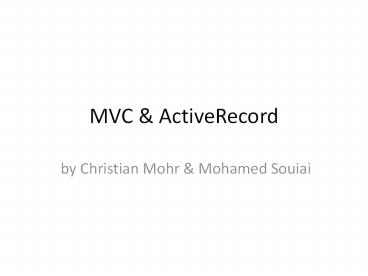MVC - PowerPoint PPT Presentation
1 / 29
Title:
MVC
Description:
MVC & ActiveRecord by Christian Mohr & Mohamed Souiai Content MVC ActionController ActionView ActiveRecord Routing Model View Controller Architectural pattern for ... – PowerPoint PPT presentation
Number of Views:105
Avg rating:3.0/5.0
Title: MVC
1
MVC ActiveRecord
- by Christian Mohr Mohamed Souiai
2
Content
- MVC
- ActionController
- ActionView
- ActiveRecord
- Routing
3
Model View Controller
- Architectural pattern for interactive
Applications. - Isolates business logic from user interface
consideration. - Grants flexibility modularity reusability of
Objects.
4
Model
- In general the model represents the information
(the data) of the application and the business
rules used to manipulate the data. - Inside Ruby on Rails the ActiveRecord Module
corresponds to the model in the MVC paradigm.
5
View
- In general the view corresponds to elements of
the user interface such as text, checkbox items. - In Rails the ActionView is used to create
Templates and visualizes the data provided by the
controller, in different formats.
6
Controller
- In general the controller manages details
involving the communication to the model of user
actions such as keystrokes and mouse movements. - In Rails the Controller is realized by the
ActionController who coordinates the interaction
between user and Application.
7
A simple bookmark projekt
- In the following slide we introduce the MVC
paradigm in the context of Ruby on rails.
8
Control center ActionController
- Tasks
- Receiving Http-Request data (i.e. Form data)
- Database requests via model-classes.
- Setting and query of cookies and sessions.
- Setting flash messages.
- Calling templates.
- Forwarding Files and data.
- Authentication .
9
Control center ActionController
UML Diagram
Our Controller class inherits from the
ApplicationController. Class AirportsController lt
ApplicationController
10
Control center ActionController
- Controller generator
- Syntax
- ruby script/generate controller name action_1
action_N - Generates the controller app/controllers/name_con
troller.rb - with optional actions
- and ActionViews app/views/name/action_n.html.er
b. - The Actions can be added manually.
- In that case, the corresponding views are not
generated automatically.
1,2
11
Control center ActionController
- Controller Actions
- The public Methods of the Controller
- Access via URL call
- http//lthostgtltportgt/ltcontrollergt/ltactiongt
3,4,5
12
ActionView
- Template-File containing Ruby- and HTML-Code.
- By Convention, the name is the same as the
corresponding action. - All View-Files have the extension .html.erb
13
ActionView
- Syntax in ActionView Files
- Ruby Code lt code gt
- Ruby Output ltoutputgt
- By using html_escape() or h() Tag-specific
characters (i.e. lt, gt and ) are masked.
14
ActionView
- Instance variables
- Variables with a leading _at_ are accessible to
all methods inside the defining controller and
the corresponding views .
15
ActiveRecord
- treating Data from a Database like Objects
- Domain Specific Language (DSL)
- ActiveReord Design pattern by Martin Fowler
- Mapping object-oriented Data to relational Data
and vice versa.
16
ActiveRecord
- Models
- Classes, that represent a data- table and are
responsible for the database operations (CRUD) - Each row in the database represents a model-object
17
ActiveRecord
- Model-Generator Syntax
- ruby script/generate model modelname
- Generates the ActiveRecord model file
app/models/modelname.rb - To create a new Row in the data table, we create
a new Object of the class modelname. - By Convention, the data table name is lower case
and plural and the model class name is in
singular with upper case initial.
6
18
ActiveRecord
- CRUD (Create, Read, Update Delete)
- The four basic database operations
- Create create a new dataset
- Read read a dataset
- Update alter an existing dataset
- Delete delete a dataset
19
ActiveRecord
- ActiveRecord-Classes provide methods for the
following basic database operations - new creates a new ActiveRecord-Object
- Create() creates and saves a new AR-Object
- Find(ID) finds the correspoding dataset
- Find(all, conditionsgt)
- It is possible to add custom methods.
7,8
20
ActiveRecord
- ActiveRecord-Objects offer the following methods
- save saving an object to the database
- update alter all or single object attributes
- destroy delete an object
21
ActiveRecord
- Interesting Functions
- Validation
- Before- and After-Filter
- Associations and Relations
- Migrations
- Transactions
- Automatic attributes (created_at, updated_at)
22
ActiveRecord
Supported relational management database systems
- Oracle
- PostgreSQL
- SQLite
- Sybas
- DB2
- Firebird
- Frontbase
- MySQL
- Openbase
23
Routing
- Defines which internal controller and action
should be called depending on the URL. - Routing rules are stored in config/routes.rb
- Auto generated entries
- ActionControllerRoutingRoutes.draw do map
- ...
- map.connect 'controller/action/id'
- map.connect 'controller/action/id.format'
- end
- Restart the server after changing the Routing!
24
Routing
Routing Diagram
25
Routing
- Links
- To generate a Link to
- http//localhost3000/bookmarks/show/1
- The code in the View would look like this
- lt link_to "show bookmarks", controller gt
'bookmarks', - action gt "show", id gt 1 gt
- There are ways to simplify this!
26
Routing
- Simplified URLs using map.connect
- Given Routing
- http//localhost3000/authentication/login
- Desired URL
- http//localhost3000/login
- Add routing-entry above standard entries
- map.connect 'login', controller gt
"authentication, action gt "login"
27
Routing
- Named Routes using map.name
- Add routing-entry above standard entries
- map.login 'login', controller gt
"authentication", - action gt "login"
- Provides login_url and login_path
- name_url contains absolute path incl. host
- name_path contains relative path without host.
28
Routing
- root route using map.root
- An applications default index page URL
- http//localhost3000/applicationname
- If no controller provided (i.e.
http//localhost3000) - the default rails welcome-page is displayed
- changing config/routes.rb entry to
- map.root controller gt "bookmarks
- makes bookmarks the root controller
- Make sure to delete homonymous files in pubic/
29
Routing
- Also possible
- Complex routing with regular expressions
- Routing with defined HTTP-Method
- (GET, POST, PUT, DELETE)
30
The end
- Thank you for listening.































